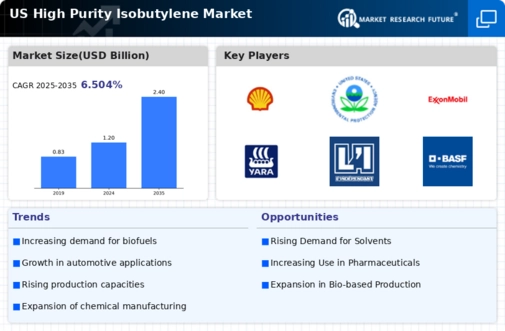The high purity isobutylene market exhibits a competitive landscape characterized by a blend of established players and emerging innovators. Key growth drivers include the increasing demand for high-performance materials in various applications, particularly in the automotive and chemical sectors. Major companies such as LyondellBasell Industries (US), ExxonMobil Chemical Company (US), and BASF Corporation (US) are strategically positioned to leverage their extensive production capabilities and technological advancements. LyondellBasell, for instance, focuses on enhancing its production efficiency through digital transformation initiatives, while ExxonMobil emphasizes sustainable practices in its operations, aiming to reduce its carbon footprint. Collectively, these strategies foster a competitive environment that prioritizes innovation and sustainability.
In terms of business tactics, companies are increasingly localizing manufacturing to mitigate supply chain disruptions and optimize logistics. The market structure appears moderately fragmented, with a few dominant players exerting considerable influence. This fragmentation allows for niche players to thrive, yet the collective strength of major companies shapes pricing strategies and market dynamics significantly.
In November 2025, TPC Group Inc. (US) announced the expansion of its high purity isobutylene production facility in Texas, a move aimed at increasing capacity to meet rising demand. This strategic expansion not only enhances TPC's market share but also positions the company to better serve its customer base in the automotive and specialty chemical sectors. The investment reflects a broader trend of companies seeking to bolster their production capabilities in response to market needs.
In October 2025, Shell Chemical Company (US) launched a new line of high purity isobutylene products tailored for the pharmaceutical industry. This strategic initiative underscores Shell's commitment to diversifying its product offerings and tapping into high-value markets. By aligning its production with the stringent requirements of the pharmaceutical sector, Shell aims to capture a larger share of this lucrative market, thereby enhancing its competitive positioning.
In September 2025, Mitsubishi Chemical Corporation (US) entered into a strategic partnership with a leading technology firm to develop AI-driven solutions for optimizing isobutylene production processes. This collaboration highlights the growing trend of digitalization within the industry, as companies seek to leverage advanced technologies to improve efficiency and reduce operational costs. The integration of AI is likely to redefine production methodologies, setting a new standard for operational excellence.
As of December 2025, the competitive trends in the high purity isobutylene market are increasingly defined by digitalization, sustainability, and technological integration. Strategic alliances are becoming pivotal in shaping the landscape, enabling companies to pool resources and expertise. Looking ahead, competitive differentiation is expected to evolve from traditional price-based competition to a focus on innovation, technology, and supply chain reliability. This shift suggests that companies that prioritize these aspects will likely emerge as leaders in the market.






















Leave a Comment